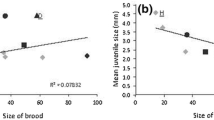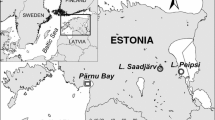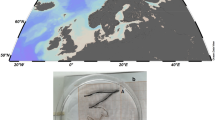Abstract
Brood size and chemical composition (carbon, nitrogen, and ash) of Pareuchaeta norvegica in Loch Etive, Scotland have been determined. From 23 to 37 eggs were found in each egg mass (mean=30 eggs). The eggs are oval; the mean size of the longer axis is 438 μm. Variation in egg mass (as dry weight) is related to increase in dry weight of the maternal body. an increase of 1 mg in maternal body dry weight produces an increase of 0.03 mg dry weight in the egg mass. Carbon content increases with increasing body dry weight both in pre-spawning and spent females, but nitrogen content decreases with increasing body weight. Thus, the carbon:nitrogen ratio increases with increasing body dry weight. The carbon content of an egg mass ranges from 61.4 to 65.3%, and nitrogen content from 9.6 to 13.2% of the total dry weight. Some examples of partitioning of chemical components of the maternal body into the egg mass are also described.
Similar content being viewed by others
Literature Cited
Chiba, T.: Studies on the development and the systematics of Copepoda. J. Shimonoseki Coll. Fish. 6, 1–90 (1956)
Conover, R.J.: Reproductive cycle, early development, and fecundity in laboratory populations of the Calanus hyperboreus. Crustaceana 13, 61–72 (1967)
Corkett, C.J. and I.A. McLaren: Egg production and oil storage by the copepod Pseudocalanus in the laboratory. J. exp. mar. Biol. Ecol. 3, 90–105 (1969)
Corner, E.D.S. and A.G. Davis: Plankton as a factor in the nitrogen and phosphorus cycles in the sea. Adv. mar. Biol. 9, 101–204 (1971)
Ikeda, T.: Nutritional ecology of marine zooplankton. Mem. Fac. Fish. Hokkaido Univ. 22, 1–97 (1974)
Marshall, S.M. and A.P. Orr: The biology of a marine copepod, 188 pp. London: Oliver & Boyd 1955
McLaren, I.A.: Some relationships between temperature and egg size, body size, development rate, and fecundity of the copepod Pseudocalanus. Limnol. Oceanogr. 10, 528–538 (1965)
Omori, M.: Weight and chemical composition of some important oceanic zooplankton in the North Pacific Ocean. Mar. Biol. 3, 4–10 (1969)
Paffenhöfer, G.A.: Cultivation of Calanus helgolandicus under controlled conditions. Helgoländer wiss. Meeresunters. 20, 346–359 (1970)
Wiborg, K.F.: Investigations on zooplankton in coastal and offshore waters of western and northwestern Norway. FiskDir. Skr. 11, 1–246 (1954)
Author information
Authors and Affiliations
Additional information
Communicated by M. Anraku, Nagasaki
Rights and permissions
About this article
Cite this article
Nemoto, T., Mauchline, J. & Kamada, K. Brood size and chemical composition of Pareuchaeta norvegica (Crustacea: Copepoda) in Loch Etive, Scotland. Mar. Biol. 36, 151–157 (1976). https://doi.org/10.1007/BF00388438
Accepted:
Published:
Issue Date:
DOI: https://doi.org/10.1007/BF00388438




